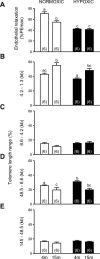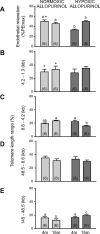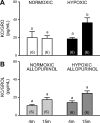Divergence of mechanistic pathways mediating cardiovascular aging and developmental programming of cardiovascular disease
- PMID: 26932929
- PMCID: PMC5036970
- DOI: 10.1096/fj.201500057
Divergence of mechanistic pathways mediating cardiovascular aging and developmental programming of cardiovascular disease
Abstract
Aging and developmental programming are both associated with oxidative stress and endothelial dysfunction, suggesting common mechanistic origins. However, their interrelationship has been little explored. In a rodent model of programmed cardiovascular dysfunction we determined endothelial function and vascular telomere length in young (4 mo) and aged (15 mo) adult offspring of normoxic or hypoxic pregnancy with or without maternal antioxidant treatment. We show loss of endothelial function [maximal arterial relaxation to acetylcholine (71 ± 3 vs. 55 ± 3%) and increased vascular short telomere abundance (4.2-1.3 kb) 43.0 ± 1.5 vs. 55.1 ± 3.8%) in aged vs. young offspring of normoxic pregnancy (P < 0.05). Hypoxic pregnancy in young offspring accelerated endothelial dysfunction (maximal arterial relaxation to acetylcholine: 42 ± 1%, P < 0.05) but this was dissociated from increased vascular short telomere length abundance. Maternal allopurinol rescued maximal arterial relaxation to acetylcholine in aged offspring of normoxic or hypoxic pregnancy but not in young offspring of hypoxic pregnancy. Aged offspring of hypoxic allopurinol pregnancy compared with aged offspring of untreated hypoxic pregnancy had lower levels of short telomeres (vascular short telomere length abundance 35.1 ± 2.5 vs. 48.2 ± 2.6%) and of plasma proinflammatory chemokine (24.6 ± 2.8 vs. 36.8 ± 5.5 pg/ml, P < 0.05). These data provide evidence for divergence of mechanistic pathways mediating cardiovascular aging and developmental programming of cardiovascular disease, and aging being decelerated by antioxidants even prior to birth.-Allison, B. J., Kaandorp, J. J., Kane, A. D., Camm, E. J., Lusby, C., Cross, C. M., Nevin-Dolan, R., Thakor, A. S., Derks, J. B., Tarry-Adkins, J. L., Ozanne, S. E., Giussani, D. A. Divergence of mechanistic pathways mediating cardiovascular aging and developmental programming of cardiovascular disease.
Keywords: allopurinol; cell senescence; fetal hypoxia; oxidative stress; xanthine oxidase.
© FASEB.
Figures



Similar articles
-
Maternal Allopurinol Prevents Cardiac Dysfunction in Adult Male Offspring Programmed by Chronic Hypoxia During Pregnancy.Hypertension. 2018 Oct;72(4):971-978. doi: 10.1161/HYPERTENSIONAHA.118.11363. Hypertension. 2018. PMID: 30354714 Free PMC article.
-
Maternal melatonin: Effective intervention against developmental programming of cardiovascular dysfunction in adult offspring of complicated pregnancy.J Pineal Res. 2022 Jan;72(1):e12766. doi: 10.1111/jpi.12766. Epub 2021 Oct 22. J Pineal Res. 2022. PMID: 34634151
-
Chronic gestational hypoxia accelerates ovarian aging and lowers ovarian reserve in next-generation adult rats.FASEB J. 2019 Jun;33(6):7758-7766. doi: 10.1096/fj.201802772R. Epub 2019 Mar 19. FASEB J. 2019. PMID: 30888848 Free PMC article.
-
Role of urate, xanthine oxidase and the effects of allopurinol in vascular oxidative stress.Vasc Health Risk Manag. 2009;5(1):265-72. doi: 10.2147/vhrm.s4265. Epub 2009 Apr 8. Vasc Health Risk Manag. 2009. PMID: 19436671 Free PMC article. Review.
-
The role of senescence, telomere dysfunction and shelterin in vascular aging.Microcirculation. 2019 Feb;26(2):e12487. doi: 10.1111/micc.12487. Epub 2018 Sep 12. Microcirculation. 2019. PMID: 29924435 Free PMC article. Review.
Cited by
-
Challenges and recommendations for the translation of biomarkers of aging.Nat Aging. 2024 Oct;4(10):1372-1383. doi: 10.1038/s43587-024-00683-3. Epub 2024 Sep 16. Nat Aging. 2024. PMID: 39285015 Review.
-
Association Between Phenotypic Age and the Risk of Mortality in Patients With Heart Failure: A Retrospective Cohort Study.Clin Cardiol. 2024 Aug;47(8):e24321. doi: 10.1002/clc.24321. Clin Cardiol. 2024. PMID: 39114957 Free PMC article.
-
Maternal electronic cigarette use during pregnancy affects long-term arterial function in offspring.J Appl Physiol (1985). 2023 Jan 1;134(1):59-71. doi: 10.1152/japplphysiol.00582.2022. Epub 2022 Nov 23. J Appl Physiol (1985). 2023. PMID: 36417201 Free PMC article.
-
Tissue chaperoning-the expanded functions of fetuin-A beyond inhibition of systemic calcification.Pflugers Arch. 2022 Aug;474(8):949-962. doi: 10.1007/s00424-022-02688-6. Epub 2022 Apr 11. Pflugers Arch. 2022. PMID: 35403906 Free PMC article. Review.
-
Circular RNA circGSE1 promotes angiogenesis in ageing mice by targeting the miR-323-5p/NRP1 axis.Aging (Albany NY). 2022 Apr 1;14(7):3049-3069. doi: 10.18632/aging.203988. Epub 2022 Apr 1. Aging (Albany NY). 2022. PMID: 35366240 Free PMC article.
References
-
- Basson M. (2008) Cardiovascular disease. Nature 541, 903
-
- World Health Organization (2012) World Health Statistics, World Health Organization, Geneva, Switzerland; ISBN 9789241564441
-
- Nichols M., Townsend N., Luengo-Fernandez R., Leal J., Gray A., Scarborough P., Rayner M. (2012) European Cardiovascular Disease Statistics 2012, European Society of Cardiology, Brussels, Belgium
-
- Browarski S., Stonebridge C., Theriault L. (2010) The Canadian Heart Health Strategy: Risk Factors and Future Cost Implications. Report of February 2010. Conference Board of Canada, Ottawa, ON, Canada
-
- Wilhelmsen L., Dellborg M., Welin L., Svärdsudd K. (2015) Men born in 1913 followed to age 100 years. Scand. Cardiovasc. J. 49, 45–48 - PubMed
Publication types
MeSH terms
Substances
Grants and funding
- MC_UU_12012/4/MRC_/Medical Research Council/United Kingdom
- PG/10/99/28656/BHF_/British Heart Foundation/United Kingdom
- FS/12/74/29778/BHF_/British Heart Foundation/United Kingdom
- WT_/Wellcome Trust/United Kingdom
- PG/14/5/30547/BHF_/British Heart Foundation/United Kingdom
- MRC_MC_UU_12012/4/MRC_/Medical Research Council/United Kingdom
- RG/11/16/29260/BHF_/British Heart Foundation/United Kingdom
- BB/E002668/1/BB_/Biotechnology and Biological Sciences Research Council/United Kingdom
- MC_UU_12012/5/MRC_/Medical Research Council/United Kingdom
- FS/09/029/27902/BHF_/British Heart Foundation/United Kingdom
- RG/06/006/22028/BHF_/British Heart Foundation/United Kingdom
LinkOut - more resources
Full Text Sources
Other Literature Sources
Medical

